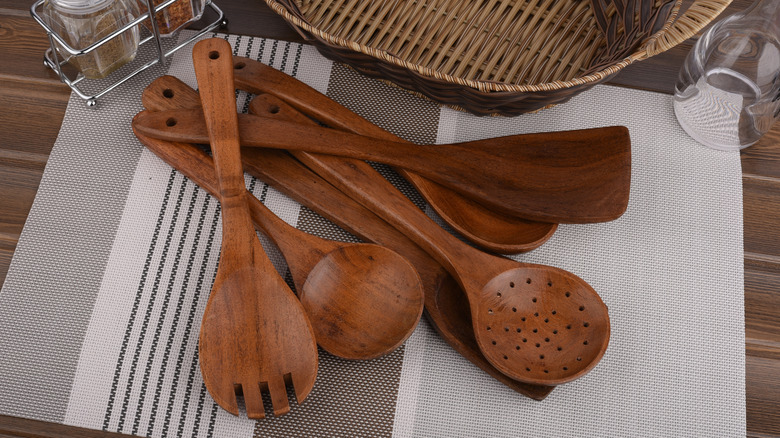The Vintage Wooden Kitchenware You Should Always Buy At The Thrift Store
From Pyrex dishes to near-mint-condition kitchen appliances, the homegoods section at your local thrift store is a haven for hidden treasures. While you can find several quality items at secondhand shops, there is one valuable kitchen item you should never overlook at thrift stores: Vintage teak wood kitchenware. Teak boasts many benefits in the kitchen, but with teak serving bowls costing upwards of $100 a piece or more, it can be quite expensive to buy new. Luckily, you can find these valuable wooden pieces at many thrift shops for a steal.
There are a few key characteristics to look out for to identify genuine, high-quality teak wood. It should have a long, mostly straight grain and deep, golden brown color. For vintage teak in particular, the color of the wood can develop a silvery patina as it ages rather than stay golden brown. This patina is a desired look when it comes to teak furniture, but it's preferable to restore teak wood to its natural color if you plan on using it in the kitchen. To do this, thoroughly clean and sand the piece before adding a food-safe teak oil to finish. In addition to these visual cues, teak wood also produces natural oils that give off an earthy or leathery smell, and it should feel decently heavy in your hand. Another easy way to identify quality teak is to look for a maker's mark: Brands known for beautiful teak kitchenware, such as Dansk, should place a marker on the bottom of the piece.
Benefits of teak wood kitchen utensils, and how to care for them
If you can get your hands on thrifted teak kitchen utensils or serving dishes, you'd quickly understand what all the hype is about. With the high oil content in teak wood, it's naturally resistant to water and decay, making it durable and reliable in the kitchen. Additionally, the wood is highly resistant to splinters and doesn't conduct heat, so you can safely rest your teak utensils atop your pots and pans. Another major benefit is how long-lasting teak wood is; with minimal care, it can last a lifetime. Plus it's completely biodegradable so you don't need to worry about utensils ending up in a landfill (unlike plastic alternatives).
To keep your teak wood kitchenware at its best, you need to do some minor upkeep. When washing these pieces, wipe them with warm water and a gentle soap and dry thoroughly instead of soaking them completely in water. You can occasionally apply a food-safe mineral oil to help nourish the wood as well. In the event your vintage teak does have some small scratches or splinters, it's vital to address these imperfections right away. In most cases, you can remove the splinter with tweezers before cleaning, sanding, and re-oiling the utensil. If you find larger cracks, or notice that your vintage teakwood kitchen item has a strange smell, it's best to let go of it. Other things to look out for include food stains; if your teak serving spoon turns red after spaghetti night, for example, make a paste with warm water and baking soda, rub the mixture onto the stain, then rinse.

